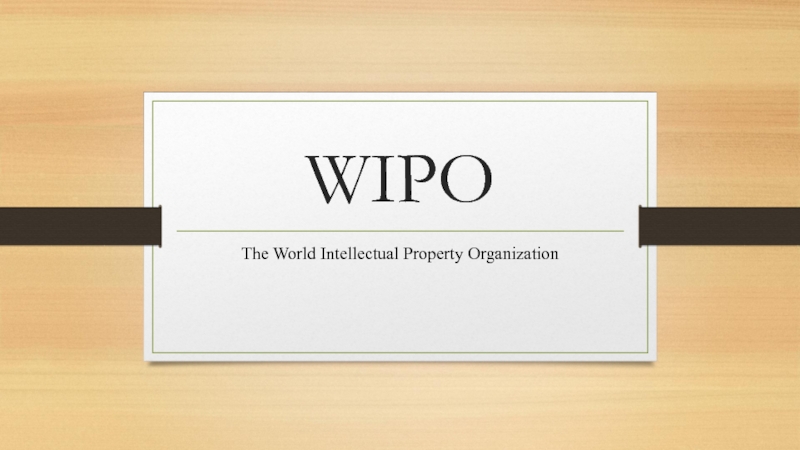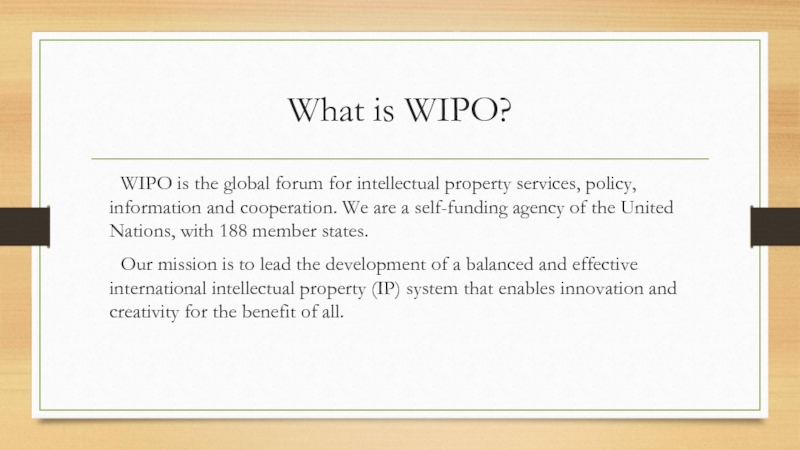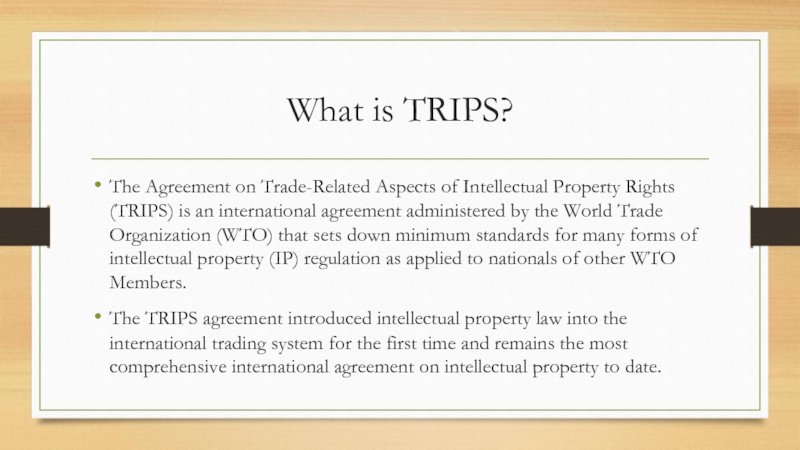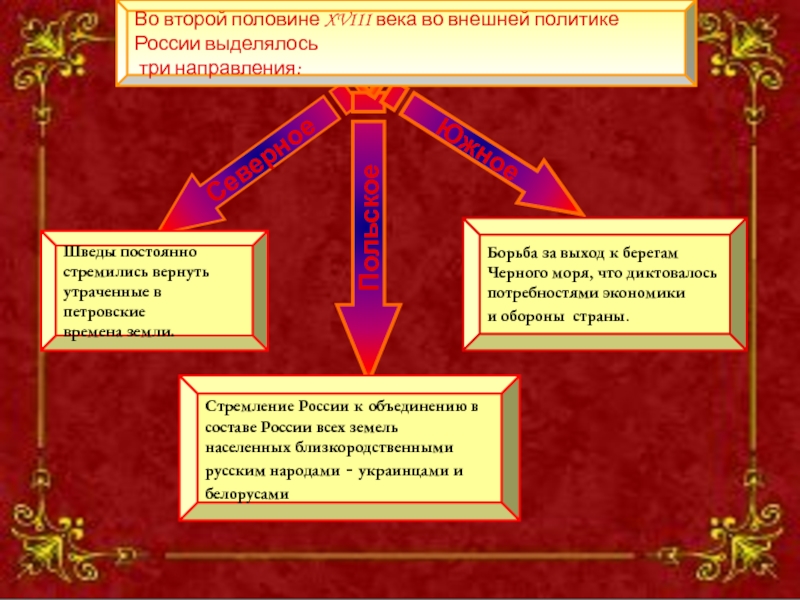Разделы презентаций
- Разное
- Английский язык
- Астрономия
- Алгебра
- Биология
- География
- Геометрия
- Детские презентации
- Информатика
- История
- Литература
- Математика
- Медицина
- Менеджмент
- Музыка
- МХК
- Немецкий язык
- ОБЖ
- Обществознание
- Окружающий мир
- Педагогика
- Русский язык
- Технология
- Физика
- Философия
- Химия
- Шаблоны, картинки для презентаций
- Экология
- Экономика
- Юриспруденция
The World I ntellectual P roperty O rganization (WIPO)
Содержание
- 1. The World I ntellectual P roperty O rganization (WIPO)
- 2. WIPOThe World Intellectual Property Organization
- 3. What is WIPO? WIPO is the global forum
- 4. What is Intellectual Property? Intellectual property (IP) refers
- 5. What WIPO does?They provide:a policy forum to
- 6. Activities by Unit
- 7. TRIPSThe Agreement on Trade-Related Aspects of Intellectual Property Rights
- 8. What is TRIPS?The Agreement on Trade-Related Aspects
- 9. Background and historyTRIPS was negotiated at the
- 10. The requirements of TRIPS (1)TRIPS requires member
- 11. The requirements of TRIPS (2) National exceptions
- 12. The requirements of TRIPS (3)No unreasonable prejudice
- 13. Implementation in developing countriesThe obligations under TRIPS
- 14. Post-TRIPS expansionGeneral objectives of these agreements include:The
- 15. CriticismSince TRIPS came into force it has
- 16. Thanks For Your Attention!!!
- 17. Скачать презентанцию
WIPOThe World Intellectual Property Organization
Слайды и текст этой презентации
Слайд 1The Agreement on Trade-Related Aspects of Intellectual Property Rights (TRIPS)
The
World Intellectual Property Organization (WIPO)
Слайд 3What is WIPO?
WIPO is the global forum for intellectual property
services, policy, information and cooperation. We are a self-funding agency
of the United Nations, with 188 member states.Our mission is to lead the development of a balanced and effective international intellectual property (IP) system that enables innovation and creativity for the benefit of all.
Слайд 4What is Intellectual Property?
Intellectual property (IP) refers to creations of
the mind, such as inventions; literary and artistic works; designs;
and symbols, names and images used in commerce.Слайд 5What WIPO does?
They provide:
a policy forum to shape balanced international
IP rules for a changing world;
global services to protect IP
across borders and to resolve disputes;technical infrastructure to connect IP systems and share knowledge;
cooperation and capacity-building programs to enable all countries to use IP for economic, social and cultural development;
a world reference source for IP information
Слайд 8What is TRIPS?
The Agreement on Trade-Related Aspects of Intellectual Property
Rights (TRIPS) is an international agreement administered by the World
Trade Organization (WTO) that sets down minimum standards for many forms of intellectual property (IP) regulation as applied to nationals of other WTO Members.The TRIPS agreement introduced intellectual property law into the international trading system for the first time and remains the most comprehensive international agreement on intellectual property to date.
Слайд 9Background and history
TRIPS was negotiated at the end of the
Uruguay Round of the General Agreement on Tariffs and Trade
(GATT) in 1994After the Uruguay round, the GATT became the basis for the establishment of the World Trade Orgnization. Because ratification of TRIPS is a compulsory requirement of World Trade Organization membership, any country seeking to obtain easy access to the numerous international markets opened by the World Trade Organization must enact the strict intellectual property laws mandated by TRIPS. For this reason, TRIPS is the most important multilateral instrument for the globalization of intellectual property laws.
Слайд 10The requirements of TRIPS (1)
TRIPS requires member states to provide
strong protection for intellectual property rights. For example, under TRIPS:
Copyright terms must extend at least 20 years, unless based on the life of the author. Copyright must be granted automatically, and not based upon any "formality," such as registrations, as specified in the Berne Convention.
Computer programs must be regarded as "literary works" under copyright law and receive the same terms of protection.
Слайд 11The requirements of TRIPS (2)
National exceptions to copyright (such
as "fair use" in the United States) are constrained by
the Berne three-step testPatents must be granted for "inventions" in all "fields of technology" provided they meet all other patentability requirements (although exceptions for certain public interests are allowed and must be enforceable for at least 20 years.
Exceptions to exclusive rights must be limited, provided that a normal exploitation of the work and normal exploitation of the patent is not in conflict.
Слайд 12The requirements of TRIPS (3)
No unreasonable prejudice to the legitimate
interests of the right holders of computer programs and patents
is allowed.Legitimate interests of third parties have to be taken into account by patent rights.
In each state, intellectual property laws may not offer any benefits to local citizens which are not available to citizens of other TRIPS signatories under the principle of national treatment (with certain limited exceptions).TRIPS also has a most favored nation clause.
Слайд 13Implementation in developing countries
The obligations under TRIPS apply equally to
all member states, however developing countries were allowed extra time
to implement the applicable changes to their national laws, in two tiers of transition according to their level of development.Слайд 14Post-TRIPS expansion
General objectives of these agreements include:
The creation of anti-circumvention
laws to protect Digital Rights Management systems. This was achieved
through the 1996 World Intellectual Property Organization Copyright Treaty (WIPO Treaty) and the WIPO Performances and Phonograms Treaty.More stringent restrictions on compulsory licenses for patents.
More aggressive patent enforcement. This effort has been observed more broadly in proposals for WIPO and European Union rules on intellectual property enforcement. The 2001 EU Copyright Directive was to implement the 1996 WIPO Copyright Treaty.
The campaign for the creation of a WIPO Broadcasting Treaty that would give broadcasters (and possibly webcasters) exclusive rights over the copies of works they have distributed.



































